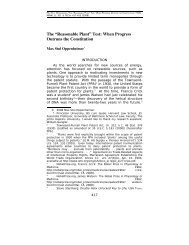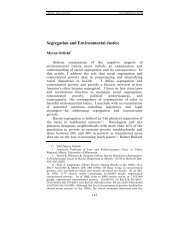An Organizational Approach to the Design of Patent Law
An Organizational Approach to the Design of Patent Law
An Organizational Approach to the Design of Patent Law
You also want an ePaper? Increase the reach of your titles
YUMPU automatically turns print PDFs into web optimized ePapers that Google loves.
6 VERTINSKY FINAL_JAD (DO NOT DELETE) 2/27/2012 2:20 PM<br />
2012] AN ORGANIZATIONAL APPROACH 239<br />
This emphasis becomes particularly important when evaluating<br />
<strong>the</strong> opportunities that patent laws <strong>of</strong>fer as policy levers<br />
in improving economic outcomes in imperfectly competitive<br />
markets that are subject <strong>to</strong> o<strong>the</strong>r forms <strong>of</strong> public and private<br />
orderings. 120<br />
4. Seek Robustness <strong>to</strong> <strong>the</strong> Political Economy <strong>of</strong> Rule Making<br />
and Engage in a Comparative <strong>An</strong>alysis <strong>of</strong> Alternative Rules<br />
The political economy <strong>of</strong> rule design and <strong>the</strong> comparative<br />
analysis <strong>of</strong> alternative regula<strong>to</strong>ry strategies within a given context<br />
are important parts <strong>of</strong> policy analysis. Those designing and<br />
implementing <strong>the</strong> rules are <strong>the</strong>mselves subject <strong>to</strong> <strong>the</strong> limitations<br />
<strong>of</strong> bounded rationality and opportunism. 121 Institutions<br />
will inevitably be imperfect, and opportunities for change will<br />
be constrained by path dependence and influenced by ideas and<br />
ideologies. 122 The design and enforcement <strong>of</strong> patent laws are<br />
both shaped by <strong>the</strong> social, cultural, and political structures in<br />
which systems <strong>of</strong> innovation are embedded, and by cognitive<br />
processes such as ideologies regarding ownership and attitudes<br />
<strong>to</strong>wards risk. 123 Alternative forms <strong>of</strong> regulation are evaluated<br />
in light <strong>of</strong> <strong>the</strong> existing institutional environment and <strong>the</strong> constraints<br />
operating on processes <strong>of</strong> rule change and adoption. 124<br />
In evaluating institutions such as patent laws and how<br />
<strong>the</strong>y change, <strong>the</strong> organizational approach retains <strong>the</strong> methodological<br />
individualism inherent in traditional neoclassical-based<br />
approaches. 125 Institutions such as patent laws are unders<strong>to</strong>od<br />
as “systems <strong>of</strong> rules created <strong>to</strong> <strong>of</strong>fset uncertainty and risk by<br />
providing a social structure that allows humans <strong>to</strong> gain certain<br />
120. See Coase, supra note 42, at 195. See also Nancy T. Gallini & Susan<br />
Scotchmer, Intellectual Property: When Is It <strong>the</strong> Best Incentive System?, 2<br />
INNOVATION POL’Y & ECON. 51, 71–72 (2002) (asserting that private contracting<br />
can alter conclusions about optimal patent design and public and private<br />
instruments and this may be complementary in reducing social costs).<br />
121. See North, supra note 115, at 17–18, 23.<br />
122. See North, supra note 92, at 97–98, 109–110.<br />
123. See North, supra note 115, at 18–20.<br />
124. See Williamson, supra note 75, at 601.<br />
125. NIE does not escape <strong>the</strong> limitations <strong>of</strong> methodological individualism.<br />
See, e.g., Robert B. Ahdieh, Beyond Individualism in <strong>Law</strong> and Economics 46–<br />
47(Emory Pub. <strong>Law</strong> Research Paper No. 9–78, 2009), available at<br />
http://ssrn.com/abstract=1518836 (<strong>to</strong> access article, select One-Click Download)<br />
(arguing that continuing methodological individualism limits understanding<br />
<strong>of</strong> institutions). In addition methodological individualism, may not<br />
adequately capture certain instrumental goals <strong>of</strong> patent law, such as goals<br />
that are based on natural rights.






